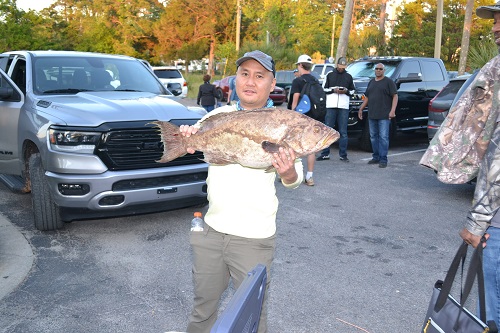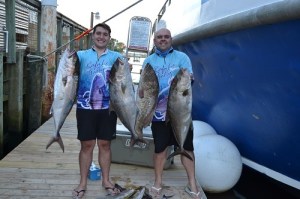Summer Offshore Fishing

 There are endless options for offshore fishing in summer. All kinds of fishing are possible, from blue marlin in Gulf Stream to sea bass on reefs. Bluewater fish may migrate within 15 miles of coast for many of the 50-mile offshore bluewater fish. The best weather is often in summer, with up to five days of calm, flat conditions.
There are endless options for offshore fishing in summer. All kinds of fishing are possible, from blue marlin in Gulf Stream to sea bass on reefs. Bluewater fish may migrate within 15 miles of coast for many of the 50-mile offshore bluewater fish. The best weather is often in summer, with up to five days of calm, flat conditions.
However, summer fishing comes with its problems. Many fish that would normally be found at the surface are forced to move deeper into the water by the hot July and August days. The summer heat can also polarize much of the feeding activity, extending it into the morning, late afternoon, and evening. The hotter part of the day is when the fisherman who has a good eye for fishing will set his baits deep in order to catch the same fish as he caught on the surface. For a summer offshore trip to be successful, planers and downriggers are essential.
Summer Fishing in Myrtle Beach
White Marlin, Blue Marlin, Sailfish
Because they are not restricted by the Gulf Stream, blue and white marlin tend to be more scattered. A king mackerel fisherman may be surprised by a marlin in 80 feet of seawater, but it is more common to find the best fishing areas with water that’s 300 to 1200 feet.
Summer is when sailfish are at their peak. Anglers have the best chance to catch sails off South Carolina in July and August. Many small sails can be hooked in 10 miles from the beach during this period, but they are often well below the minimum 57-inch fork length required by law. These fish are best found in areas with weed lines, current rips, and natural reefs that lie between 120-300 feet of water.
Sails weigh in at 35 to 45 pounds and prefer smaller baits than their larger cousins, the marlins. Sailfish can be caught trolling with small to medium-sized ballyhoo or mullet, with a small artificial lure placed in front of the bait. Sails are able to readily take small to medium-sized lures, and even have been caught on spoons or plugs for king mackerel.
Blue marlin are usually between 125 and 200 pounds in summer. This is well below the minimum fork length of 86 inches. Popular and effective baits include large mullet, ballyhoo and ladyfish rigged to skim or swim across the surface. These baits are often dressed with brightly colored plastic skirts or artificial lures.
Brightly colored, large artificial lures that are 10- to 16 inches long and brightly colored can also be very effective in catching marlin. Natural baits are real food, so if a fish strikes too quickly it will return to the bait. Artificial lures are less likely to produce this effect. Artificial lures, on the other hand, can be trotted faster and allow for more fishing.
Dolphin, Wahoo, Yellowfin Tuna

Anglers have an exceptional opportunity to catch game fish close to shore in summer than any other season. Yellowfin tuna, wahoo, and dolphin can be found within 90 feet of the water surface. However, the areas between 180 feet and 600 feet will have the highest concentrations.
The size of dolphins and wahoos gradually decreases as summer progresses. The norm at summer’s beginning is a 10- to 20-pound dolphin, and a 35- to 50-pound wahoo. However, the average weight of dolphin and wahoo drops to 8 and 20 respectively by summer’s end. Yellowfin tuna, on the other hand, grows in size all year and averages 45 pounds by the end of summer.
Ballyhoo and mullet, rigged with small to medium-sized artificial lures or skirts, produce more game fish than any other baits. For big fish, large artificial surface lures can also be effective. All baits can be fished from the surface using outriggers. However, it is a good idea to use a downrigger to ensure at least one line is 60-70 feet deep.
Amberjack and Barracuda
This time of year, barracuda and amberjack are the best for fishing on artificial reefs or coastal shipwrecks. These fish can be picky in summer, but live bait can help. Anglers have the chance to not only test their equipment, but also their angling skills.
Anglers often approach amberjack with a 50-pound class outfit. It can be thrilling to challenge these fish with a 30- or 20-pound test line. Barracuda are usually smaller than the AJ’s at 10 to 15 pounds. However, you will still encounter barracuda weighing between 30 and 40 pounds. Ideal is light tackle between 12 and 20 pounds. For cudas with sharp teeth and heavy jaws, wire leader is required. Monofilament, 100-150-pound test, works well for the jacks.
Large, live baits like 8-to 14-inch mullet or menhaden can be floated to the surface above the shipwrecks. A 5/0 to 7/0 extra-strong hook should be used depending on the line test. A stainless steel hook is preferred since most fish are released, not eaten.
Artificial lures can also be used to catch barracuda and amberjack. Casting or trolling the Cuda Killer is extremely effective. Deep diving spoons are preferred by Amberjacks. Both will be enticed by the sound of a surface lure.
King Mackerel
The summer season of Kingfishing has its ups and downs. It seems to switch on and off every 2 to 3 weeks. Larger female fish (usually 20 to 40 pounds) are found in nearshore waters, just outside of bays and sounds. In 60 to 120 feet of water, smaller males (between 6 and 12 pounds) can be found. These schooling fish are attracted to natural and artificial reefs.

Trolling baits on the surface in the early morning is a great way to get fish. The fish will usually call for warmth by 10 a.m. Smart anglers will bring out their downriggers or planers at this point. Remember to keep your lure or bait at least 10 feet away from these deep-running devices when fishing.
Kingfish can be picky, so anglers use everything, from artificial lures to the offshore panacea, the rigged ballyhoo. You can also use live bait such as mullet, menhaden and mullet that are 6- to 10 inches long, drifted or slow trolling. To locate the fish, these should be fished at different depths with a live bait rod.
Also, spoons and running plugs work well. For trolling, you can use colored plastic skirts, seawitches, and Hawaiian eyes for dressing up your ballyhoo. These lures can be fished at different depths to catch fish, just like live baits.
Spanish Mackerel, Little Tunny, Crevalle Jack
Spanish mackerel and little tunny are often abundant near shore waters for up to 15 miles during this time. Crevalle jack, also known as bonito (or little tunny), is a great game fish that is not very well-liked for its food value. Tunny weigh around 10 pounds and crevalles are about 5 pounds.
Bottom Fish
The heat of summer can also affect bottom fishing in Myrtle Beach. The heat of summer will cause sea bass, porgies, snappers, and other reef fish to scatter, taking over small areas of reef or living bottom habitat. This results in more areas that are fishable, but smaller schools. Deepwater fishes often slow down their feeding activity in the middle of the day. Many bottom fishermen make overnight trips to fish late at night, into the morning and into the evening.
Black sea bass (or blackfish) are found in 40 to 120 feet of the water. They average between 1 and 2 pounds. However, the best fishing is done in 50-70 feet of water, on ledges or near live bottom areas. Blackfish will stay close to structures so anchoring directly over them is a must.
Sea bass are one of the most aggressive feeders of fish. Cut squid is the preferred bait because it is hardy and well-liked by fish. A bottom rig using a two-hook system with 3/0 to 5-/0 hooks, and a 6-to 12-ounce sinker is the most common.
The water depth at which snapper, triggerfish, triggerfish, and grouper can be found is 50 feet. However, the highest concentrations are in 90-180 feet of water. These fish are similar to sea bass.
Call Voyager Deep Sea Fishing & Dolphin Cruises now if you’re looking to go fishing in Myrtle Beach.
Voyager Deep Sea Fishing & Dolphin Cruises
1525 13th Ave N
North Myrtle Beach, SC 29582
(910) 575-0111
(843) 626-9500
http://supervoyagerdeepseafishing.com/
